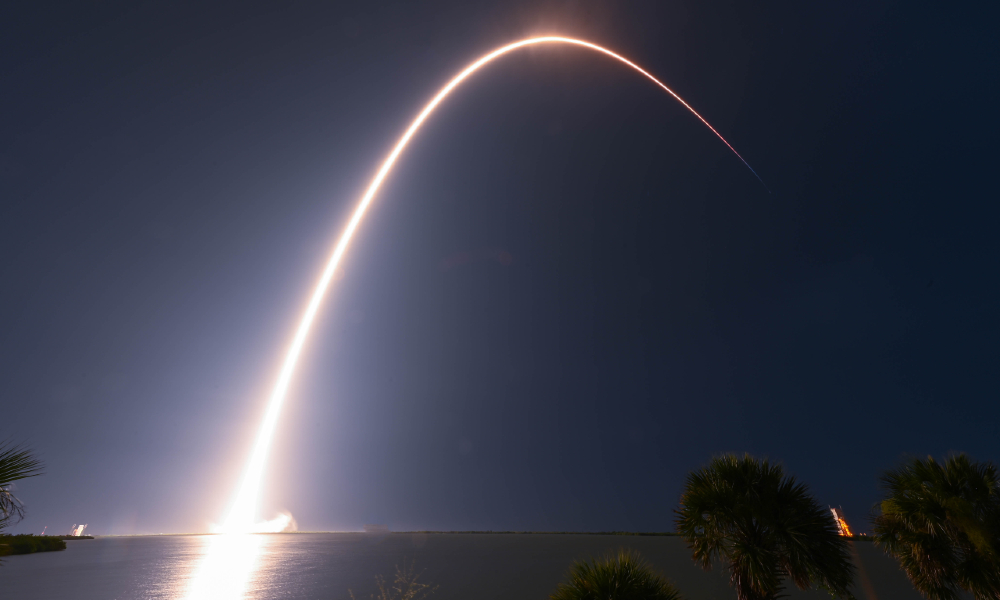The United States Has Always Prepared to Fight a Space War

Published by The Lawfare Institute
in Cooperation With

Editor’s Note: The United States has long accepted that the militarization of space is necessary for U.S. security. My Center for Strategic and International Studies colleague Clayton Swope contends that the United States has long emphasized that space is vital for U.S. military operations and has opposed treaties and initiatives that push space demilitarization.
Daniel Byman
***
The U.S. military has long understood it must prepare to fight in space and protect satellites that play a critical role in winning wars on Earth—a fact that U.S. allies increasingly recognize as well. The creation of the Space Force and reestablishment of the Space Command, announcement of the Golden Dome missile shield, and increased defense space spending by Germany are merely recent chapters in the story. However, some experts and countries—including, not surprisingly, Russia and China—suggest these developments signal a pivot, threaten peace, or might run afoul of international law.
Many of these observations are anchored in a belief that outer space, from a legal perspective but also on principle, has been reserved only for peaceful purposes. While that may be a laudable aspirational goal, it has been neither a reality nor stipulated in any binding international agreement. Since the dawn of the space race, international treaties, as well as U.S. policies and actions, have always reflected the position that space will be used for both military and nonmilitary purposes. As far back as 1959, senior U.S. leaders were clear that space should be used to gain “scientific knowledge, military strength, economic capabilities, and political position.” These are the same goals for U.S. efforts in space today.
To a large degree, national policies and international agreements about what types of activities should be permitted in outer space date back to the start of the Cold War and reflect a tension—dating back even further to Robert H. Goddard’s rocket research in the 1910s—about why nations have sought to develop technologies to reach space in the first place. On the one hand, countries have built rockets, satellites, and spacecraft to explore the cosmos, make scientific discoveries for the benefit of humankind, and peacefully pursue economic and commercial opportunities in orbit. On the other hand, nations have aimed to use all those same technologies for military advantage. The first artificial object to reach outer space was an Aggregat-4 rocket, more commonly known as the V-2 ballistic missile, designed and launched by Nazi Germany in June 1944.
For a short time, both the United States and the Soviet Union considered limiting the use of outer space to exclusively peaceful purposes. In a 1957 speech at the United Nations, a senior U.S. official proposed creating an international inspection system to ensure outer space would be used “for exclusively peaceful and scientific purposes.” However, U.S. and Soviet leaders soon realized they could not ignore the central role space played in nuclear deterrence—all ballistic missiles passed through space. A 1959 U.S. space policy stated that space should be free and available for peaceful uses by all nations, while not “necessarily exclud[ing] military applications.” A 1958 proposal from the Soviet Union banning military activities in space also called for a concurrent ban on operating foreign military bases; Soviet leaders worried that reserving space for solely peaceful purposes would leave the Soviet Union at a disadvantage, as the United States could stage short-range missiles at foreign U.S. bases in Europe.
Soon, the public U.S. position began to reflect the recognition, already made in the then-classified 1959 space policy, that it was neither practical nor desirable to ban all military uses of space. In a December 1962 speech at the United Nations, Sen. Albert Gore Sr., while describing the difficulties in discriminating between military and nonmilitary uses of space and the dual-use nature of satellites, said:
The question of military activities in space cannot be divorced from the question of military activities on earth. To banish these activities in both environments we must continue our efforts to general and complete disarmament with adequate safeguards. Until this is achieved, the test of any space activity must be not whether it is military or non-military, but whether or not it is consistent with the United Nations Charter and other obligations of international law.
This dual-track approach—an emphasis on the peaceful exploration and use of space, while acknowledging the role of space for military purposes—has underpinned subsequent U.S. space policy and public messaging up to the present day.
This balance is also reflected in the Outer Space Treaty of 1967, generally recognized as the foundation of international space law. The Outer Space Treaty imposed some restrictions on military activities, banning the “stationing” of nuclear weapons or “other weapons of mass destruction” in space. The treaty also prohibits military activities on the Moon and other celestial bodies (that is, other planets, moons, and asteroids). The nonbinding preamble recognizes the “interest of all mankind in the progress of the exploration and use of outer space for peaceful purposes,” while not ruling out the use of space for military purposes. Additionally, the Partial Test Ban Treaty of 1963 prohibited the testing of nuclear weapons or any other nuclear explosions in outer space. The United States and the Soviet Union ratified three other international agreements addressing outer space issues between 1968 and 1975, though none of these agreements placed further restrictions on the use of outer space for military purposes.
In 1978, the United States and the Soviet Union began arms control talks covering anti-satellite weapons. After three rounds of discussions, the United States halted negotiations, noting that it did not see how current technology would allow it to verify treaty compliance, a position it reiterated in the mid-1980s. To keep diplomatic pressure on the United States, in 1981 the Soviets introduced a UN resolution proposing a treaty to prevent an arms race in outer space; this resolution led to a 2008 joint Russia-China proposal for a new space arms control treaty, called the Treaty on the Prevention of the Placement of Weapons in Outer Space. The United States and its allies have consistently raised objections to the draft treaty and a 2014 revision, pointing out the challenges to verification and difficulty in defining what precisely would be considered a weapon in space. To date, the Outer Space Treaty—complemented by a handful of other treaties, including the Partial Test Ban Treaty, with small parts to play on governance of military space activities—remains the main international agreement governing military activities in space, albeit in a limited manner.
Space steadily became more important to U.S. military thinking, going well beyond the initial focus on nuclear weapons and influenced by the concepts and technologies investigated as part of President Reagan’s Strategic Defense Initiative, a proposed U.S. ballistic missile shield that would have included space-based missile defenses. The 2001 Quadrennial Defense Review noted that “surveillance, ground-based lasers and space jamming capabilities, and proximity micro satellites are becoming increasingly available. A key objective for transformation, therefore, is not only to ensure the U.S. ability to exploit space for military purposes, but also as required to deny an adversary’s ability to do so.” In 2010, the Obama administration issued a space policy that said the nation would defend U.S. “space systems and contribute to the defense of allied space systems, and, if deterrence fails, defeat efforts to attack them.” The first Trump administration’s space policy, issued in 2020, reflects the same sentiments, noting that the United States will “conduct operations in, from, and through space to deter conflict, and if deterrence fails, to defeat aggression while protecting and defending United States vital interests with allies and partners.” In 2021, the Biden administration issued a space policy that called for the defense of “national security interests from the growing scope and scale of space and counterspace threats.”
There are no international agreements banning all military activities in space because such agreements are neither practical nor enforceable. Today, U.S. plans and rhetoric about military activities in space, as well as those of its close allies, entirely align with U.S. space policies dating back to the 1960s as articulated by presidents from both political parties and international treaties dealing with outer space. The U.S. position and its actions today should not surprise anyone. Concerns about outer space militarization, weaponization, or arms races—in any possible way that those concepts and phrases are specifically defined—attempt to treat outer space differently from all other environments in which nation-states interact and conduct their affairs. The United States, consistent with its international obligations, treats space the same as any other place, such as the high seas, in which wars may one day be fought—and has rightly worked to prepare for such a contingency, without treating such a war as a foregone eventuality.
Both nonmilitary and military activities will happen in space, a fact entirely permissible under international law and consistently represented in U.S. actions and policies over nearly 70 years. Until humankind entirely gives up pursuing the “continuation of policy by other means,” there is no reason to expect outer space will be immune from war and all that warmaking entails.





